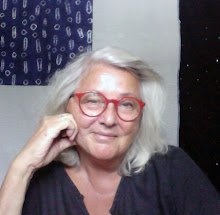A post about the recent exhibition at the Mississippi Valley Textile Museum, Almonte Ontario, Reiko Sudo and Nuno: Textiles from Japan
Curated by Alan C. Elder from the Canadian Museum of Civilization, the exhibition was designed by Reiko Sudo in the wabi sabi - beautiful Norah Rosamond Hughes Gallery, a re-configured space in what used used to be a working woolen weaving factory . In the above photo, one of the twenty -two columns is wrapped red polyester fabric, Paper Roll 2002, a chemical lace embroidery designed by Reiko Sudo in 2002.
When Alan C, Elder showed Reiko Sudo images of the gallery, she focused her attention on the columns that line up in the temporary exhibition space and dressed them in her original fabrics. The white pleated and slashed polyester screen on one of the walls is named Tanabata, and was designed in 2004 by Reiko Sudo and Hiroko Suwa. (Tanabata is a traditional annual festival. On the seventh day of the seventh lunar month, girls pray to become good at sewing by decorating bamboo with folded paper charms.
Scrapyard, 1994 designed by Reiko Sudo and Hiroko Suwa. Rust dyeing, 100% rayon and iron.
This exhibition was not only serenely beautiful, it was also very informative for those of us interested in surface design. A dedicated wall of samples served to explain the variety of processes used to create the fabrics was an integral part of the exhibit. Scrapyard was made by laying damp fabric on a square of rusty iron, shown above.
Length of time was the variable in how densely the material would be coloured.
The exhibition was in Canada from July 11 - November 22, 2014) and celebrated the 30th anniversary of NUNO, the Tokyo based textile studio, and Reiko Sudo's association with it.
The natural light and the decrepit stone walls of the historic building added to the elegance and mystery of these minimalist yet sensuous fabrics. Above, Cracked Denim Rounds, 2010 designed by Reiko Sudo and Hiroko Suwa. Burnout and bonding, cotton and polyester.
Denim was originally a French twill called serge de Nimes.
Flower Almanac , 2006 designed by Reiko Sudo. Jacquard weave, 100 percent cotton.
A double weave in threads of different hefts and twists.
detail of Skylights, 2012 designed by Reiko Sudo. Another double weave. 98% cotton, 2% polyurethane.
left: Kamaboko Stripe, 2014 Designed by Reiko Sudo, jacquard weave, 100% cotton, Right: Skylights 2012.
Visitors were invited to touch the samples.
By handling the cloth and reading the details, we learn.
Congratulations to Michael Rikley-Lancaster, Executive Director and Curator of the Mississippi Valley Textile Museum, and to all of the many who were involved in bringing such an important international exhibition to Almonte. A catalog of the exhibition is available from the museum, with essays by Alen C. Elder, Naomi Pollock and Yoko Imai accompanying photographs of each cloth.
Subscribe to:
Post Comments (Atom)






























This exhibition is one of its kind. It is absolutely wonderful. I have not seen such a unique variety of papers before. Great work.
ReplyDelete